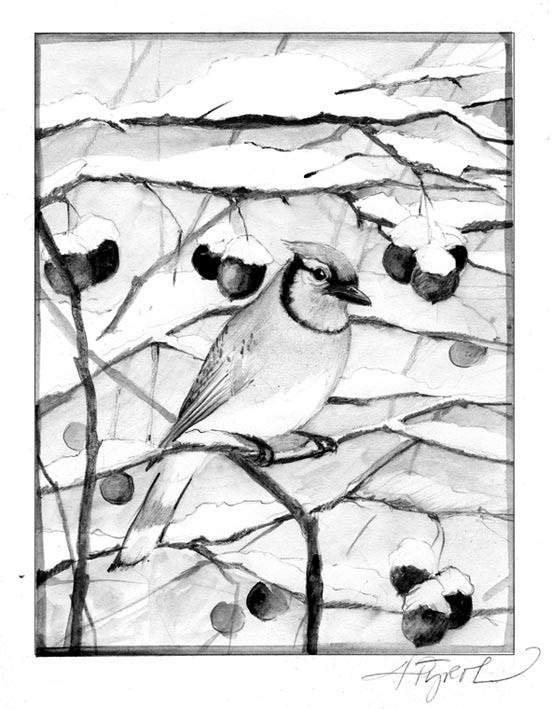
Two winters past a pair of Carolina wrens frequented our bird feeder. The male greeted the dawn with an ebullient “tea-kettle, tea-kettle, tea-kettle.” After sunset, the intrepid wrens retired to the warmth and safety of our barn. Early each day, when I opened the door, I bid them, “Good morning,” and was reminded of a friend who once had an eastern towhee, another bird not common to the season, over-winter in his barn in Barnard, Vt. The resourceful towhee roosted in the warm corner of the barn near the animals and helped itself to some of their grain.
Barns aside, visiting friends who enjoy the winter birds at our feeder often ask how any bird could possibly survive sub-zero nights. Answer: The shelter and insulation provided by thick evergreens and dense shrubs, which are the most common nocturnal winter roosts for many birds. One of our popular bird feeders hangs near a row of bushy white pines. Come sunset, blue jays, juncos, mourning doves and cardinals fly into these pines and settle for the night, somewhat protected from cold winds, snow and rain.
Birds also spend winter nights in hollow trees, in old nest cavities, under peeling bark, in vines covering buildings and under eaves. Purple finches roost en masse in the pines and hemlocks. Birds that nest in cavities during breeding season often use tree hollows for winter shelter; these include chickadees, titmice, nuthatches, screech owls and both downy and hairy woodpeckers. Wintering white-breasted nuthatches pool their body heat by huddling in groups of up to two-dozen.
Turkeys and crows often flock in evergreen treetops, pooling body heat, the latter congregating in groups of as many as several hundred. Crows return to the same roost each night from as far as 20 miles away.
Not all birds take to the trees for protection. The ruffed grouse, for example, digs under snow or dive-bombs into a snow bank to hollow out a tunnel. Within this warmer snow shelter, in ideal circumstances, grouse will expend roughly half the energy they would need in the open. Grouse also have downy plumes that branch from their main feathers, a nice coat to wear while surrounded by snow.
With less daylight in winter, birds have less time to forage, just at the time of the year when they need more food for more energy to stay warm during the long night. The Carolina wrens that frequented our yard found the perfect combination: plentiful food and a shelter with an actual roof over their heads to help conserve energy.
In his book, “Life in the Cold,” the renowned field biologist and winter ecologist Peter Marchland says that most songbirds have just enough fat reserves to survive one extremely cold winter night. So, it is critical that they retain their body heat as much as possible. To keep their body temperatures within the necessary range of 104 to 109 degrees F., birds grow a thicker coat of insulating feathers as winter approaches. The winter coats of goldfinches and redpolls, for example, are 50 percent thicker than their summer plumage. Birds can also increase insulation by 50 percent, simply by fluffing up their feathers.
In extreme cold, birds tend to tuck in their necks, legs and wings to avoid losing heat from these extremities. Scientists have found that reducing their exposed surface area by one-fourth decreases heat loss by an equal amount.
These and other heat-conservation techniques usually work, but when they prove inadequate, birds have yet another strategy at their disposal: shivering. When their body temperatures begin dropping, they shiver to generate body heat. According to Marchand, shivering goldfinches were observed increasing their typical heat output five fold when exposed to very cold temperatures in a laboratory.
Besides shivering, birds have an internal heat exchange system that helps maintain their core temperature. As warm arterial blood is pumped toward the cold feet, that blood comes into close contact with the cooler blood returning through the veins to the heart. This near-contact warms the venal blood so that it doesn’t unduly chill the body core as it returns to the heart.
As well equipped as birds are for surviving winter nights, there are ways humans can help. Among them: Pile sheltering brush piles in the woods; leave dead trees standing for the birds that roost in cavities; cut small access holes in sheds for winter birds seeking shelter. Come spring, consider planting thick evergreens for winter cover and put in a few berry-bearing shrubs to provide cold-weather food.
And finally, don’t forget to leave that barn door open by just a feather for the wrens and towhees.

